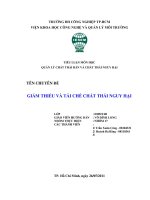Tài liệu Chất thải nguy hại - hazardous waste pptx
Bạn đang xem bản rút gọn của tài liệu. Xem và tải ngay bản đầy đủ của tài liệu tại đây (704.2 KB, 11 trang )
1
6/19/2005 1
CHẤT THẢI NGUY HẠI
hazardous waste
ThS. Trần Minh Hải
6/19/2005 2
Khái niệm: Chất nguy hại
(hazardous materials)
z là những chất có tính độc hại tức thời đáng kể
hoặc tiềm ẩn
đối với con người và sinh vật
khác
z do:
{ không phân hủy sinh học hay tồn tại lâu bền trong
tự nhiên;
{ gia tăng số lượng đáng kể không thể kiểm soát;
{ liều lượng tích lũy đến một mức nào đó sẽ gây tử
von
g
ha
y
g
â
y
ra nhữn
g
tác độn
g
tiêu cực.
2
6/19/2005 3
Tính chất
{Dễ cháy (Ignitability): T < 60
o
C, masat,…
{Tính ăn mòn (Corossivity): pH < 3; pH >12,5;
{Hoạt tính hoá học cao (Reactivity)
{Tính độc hại (Toxicity):
{Khả năng gây ung thư (Carcinogenicity) và đột biến
gen
6/19/2005 4
DOT Hazard Classes
Miscellaneous (ORMs)9
Corrosives8
Radioactive materials7
Poisons, etiologic agents6
Oxidizers, organic peroxides5
Solids4
Liquids3
Gases2
Explosives1
HAZARD TYPEHAZARD CLASS
3
6/19/2005 5
Explosives
Explosives: Designed to function with instantaneous
release of gas and heat (i.e., by exploding).
Blasting Agents: Designed to explode, but require a
blasting cap to trigger the explosion
6/19/2005 6
Gases
Anhydrous Ammonia is classified as a non-flammable gas
However, it is flammable and highly toxic!
Chlorine gets its own placard because it is toxic, corrosive,
and an oxidizer!
Poison A: Gases or liquids producing vapors highly
hazardous to human health.
4
6/19/2005 7
Liquids
Flammable Liquid: Flash point < 100
o
F
Combustible Liquid: Flash point > 100
o
F
6/19/2005 8
Solids
Any solid material other than an explosive that is liable to
cause fires through friction, through retained heat from
manufacturing, or which can be ignited readily and when
ignited burns vigorously and persistently.
5
6/19/2005 9
Oxidizers
Liquid oxygen is an oxidizer and a cryogenic agent.
Oxidizers will readily give up oxygen and support
combustion.
Organic oxidizers will readily give up oxygen, support
combustion, and will burn!
6/19/2005 10
Poisons
Class B Poisons: Solids and liquids known
to be so toxic as to afford a risk to human
health or which, in the absence of adequate
data are assumed to be toxic to man.
Irritants, substances that give off irritating
fumes when heated or exposed to air, are
included in Class 6, but are placarded only
as DANGEROUS and only if >1000 pounds
is present.
Etiologic agents are included in Class 6 but
are not placarded.
6
6/19/2005 11
Radioactive Materials
Vehicles transporting radioactive materials are
placarded ONLY
if the packages contains material
measures >50 millirem/hr on the entire package
surface or >3 millirem/hr at 3 feet. (Radioactive III
package labeling)
Defense material being moved under authority of
the Department of Energy or Department of
Defense is NOT
placarded.
6/19/2005 12
Corrosives
Materials that attack and destroy
living tissue or that produce severe
corrosion of steel.
Frequently are also toxic and
reactive.
7
6/19/2005 13
Dangerous
Class C Explosives
Irritants
Mixed motor vehicle loads of
>1000 but <5000 pounds of all
HAZMAT except Poison A,
Poison B, Solid Dangerous
when Wet, Explosive A,
Explosive B, and Radioactive
6/19/2005 14
UN Numbers
8
6/19/2005 15
Nhãn báo chất nguy hại
z Nhãn báo chất nguy hại
6/19/2005 16
Nhãn hướng dẫn sử dụng
z Handling labels
9
6/19/2005 17
Xử lý chất nguy hại
z Tận dụng
z Đốt
z Thải bỏ cuối cùng
6/19/2005 18
Tận dụng dung môi
z Đồng Nai, DNTN. Tân Phát Tài
10
6/19/2005 19
Taùch daàu khoaùng
6/19/2005 20
Loø nung thuøng quay
z Rotary kiln
incinerator
11
6/19/2005 21
Ñoát taàng soâi
z Bubbling
fluidised
bed
6/19/2005 22
Ñoát taàng soâi
• Circulating
fluidised
bed









